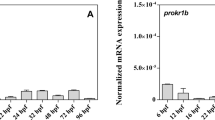Abstract.
Infertility and inability to smell are the phenotypical features of Kallmann’s syndrome (KS), a genetic disease which affects 1 in 10,000 males and 1 in 50,000 females, the majority of the cases being sporadic. The molecular pathogenesis of KS is complex but mainly referable to the impairment of olfactory axon development and of the migration of gonadotropin-releasing hormone (GnRH) neurons. Only two different genes have been identified so far as responsible for the disease: KAL1 and KAL2, encoding anosmin-1 and fibroblast growth factor receptor 1 (FGFR1), respectively. In this review we focus our attention on insights evoked by recent studies, which propose a new direct role for anosmin-1 in the migration GnRH neurons, and a fascinating hypothesis of interactions between anosmin-1 and FGFR1 systems.
Similar content being viewed by others
Author information
Authors and Affiliations
Corresponding author
Additional information
Received 23 December 2005; received after revision 31 May 2006; accepted 6 July 2006




